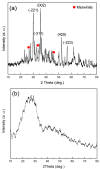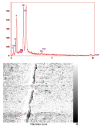Evaluation of Mechanical Properties of Glass Ionomer Cements Reinforced with Synthesized Diopside Produced via Sol-Gel Method
- PMID: 36903222
- PMCID: PMC10004627
- DOI: 10.3390/ma16052107
Evaluation of Mechanical Properties of Glass Ionomer Cements Reinforced with Synthesized Diopside Produced via Sol-Gel Method
Abstract
This study aimed to fabricate a glass ionomer cement/diopside (GIC/DIO) nanocomposite to improve its mechanical properties for biomaterials applications. For this purpose, diopside was synthesized using a sol-gel method. Then, for preparing the nanocomposite, 2, 4, and 6 wt% diopside were added to a glass ionomer cement (GIC). Subsequently, X-ray diffraction (XRD), differential thermal analysis (DTA), scanning electron microscopy (SEM), and Fourier transform infrared spectrophotometry (FTIR) analyses were used to characterize the synthesized diopside. Furthermore, the compressive strength, microhardness, and fracture toughness of the fabricated nanocomposite were evaluated, and a fluoride-releasing test in artificial saliva was also applied. The highest concurrent enhancements of compressive strength (1155.7 MPa), microhardness (148 HV), and fracture toughness (5.189 MPa·m1/2) were observed for the glass ionomer cement (GIC) with 4 wt% diopside nanocomposite. In addition, the results of the fluoride-releasing test showed that the amount of released fluoride from the prepared nanocomposite was slightly lower than the glass ionomer cement (GIC). Overall, the improvement in mechanical properties and optimal fluoride release of prepared nanocomposites can introduce suitable options for dental restorations under load and orthopedic implants.
Keywords: diopside nanoparticles; fluoride release; glass ionomer cement; mechanical properties.
Conflict of interest statement
The authors declare no conflict of interest.
Figures













References
-
- Khan A.S., Khan M., Rehman I.U. Nanoparticles, Properties, and Applications in Glass Ionomer Cements. Eur. J. Mol. Clin. Med. 2012;7:93–108. doi: 10.1016/b978-1-4557-3127-5.00005-2. - DOI
-
- Iaculli F., Salucci A., Di Giorgio G., Luzzi V., Ierardo G., Polimeni A., Bossù M. Bond Strength of Self-Adhesive Flowable Composites and Glass Ionomer Cements to Primary Teeth: A Systematic Review and Meta-Analysis of In Vitro Studies. Materials. 2021;14:6694. doi: 10.3390/ma14216694. - DOI - PMC - PubMed
-
- Ratnayake J., Veerasamy A., Ahmed H., Coburn D., Loch C., Gray A.R., Lyons K.M., Heng N.C.K., Cannon R.D., Leung M., et al. Clinical and Microbiological Evaluation of a Chlorhexidine-Modified Glass Ionomer Cement (GIC-CHX) Restoration Placed Using the Atraumatic Restorative Treatment (ART) Technique. Materials. 2022;15:5044. doi: 10.3390/ma15145044. - DOI - PMC - PubMed
-
- Bilgrami A., Maqsood A., Alam M.K., Ahmed N., Mustafa M., Alqahtani A.R., Alshehri A., Alqahtani A.A., Alghannam S. Evaluation of Shear Bond Strength between Resin Composites and Conventional Glass Ionomer Cement in Class II Restorative Technique—An In Vitro Study. Materials. 2022;15:4293. doi: 10.3390/ma15124293. - DOI - PMC - PubMed
LinkOut - more resources
Full Text Sources

